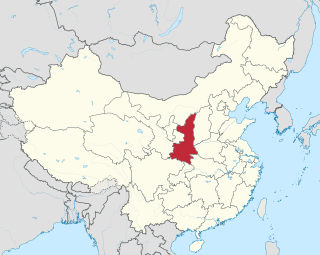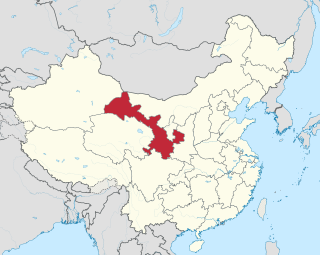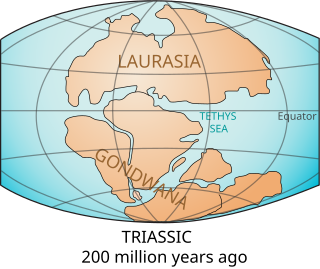
Laurasia was the more northern of two supercontinents that formed part of the Pangaea supercontinent around 335 to 175 million years ago (Mya). It separated from Gondwana 215 to 175 Mya during the breakup of Pangaea, drifting farther north after the split.

The United States Court of Appeals for the Ninth Circuit is a U.S. Federal court with appellate jurisdiction over the district courts in the following districts:

The Chinese Grand Prix is a round of the Formula One World Championship. It is currently held at the Shanghai International Circuit, Jiading, Shanghai, designed by Hermann Tilke. When completed in 2004, it was the most expensive Formula One circuit facility, costing US$240 million. Abu Dhabi became the most expensive at US$6 billion when it opened in 2009. The track is 5.451 km long and features one of the trickiest corners combinations on the Formula One calendar, comparable to that of Istanbul Park's turn 8, also designed by Tilke. Turn 1 and 2 are a very demanding 270-degree, right-handed corner combination that requires a lot of speed whilst entering and it tightens up towards the end.

The United States Court of Appeals for the Eleventh Circuit is a federal court with appellate jurisdiction over the district courts in the following districts:
The history of the administrative divisions of the Imperial China is quite complex. Across history, what is called 'China' has taken many shapes, and many political organizations. For various reasons, both the borders and names of political divisions have changed—sometimes to follow topography, sometimes to weaken former states by dividing them, and sometimes to realize a philosophical or historical ideal. For recent times, the number of recorded tiny changes is quite large; by contrast, the lack of clear, trustworthy data for ancient times forces historians and geographers to draw approximate borders for respective divisions. But thanks to imperial records and geographic descriptions, political divisions may often be redrawn with some precision. Natural changes, such as changes in a river's course, or loss of data, still make this issue difficult for ancient times.

Guangyuan is a prefecture-level city in Sichuan Province, China. It has an area of 16313.78 square kilometers and a population of 2,484,123 in 2010
Lizhou District (利州) is a district in Guangyuan, Sichuan, China.
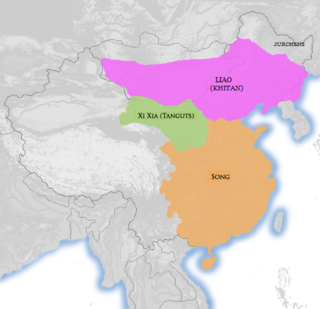
The Liao dynasty was an empire established by the Khitans. This article discusses the provincial system that existed within the Liao dynasty from the early 10th century until the fall of the empire in 1125, in what is now North China, Northeast China and Mongolia.

The Northern Silk Road is a prehistoric trackway in northern China originating in the early capital of Xi'an and extending north of the Taklimakan Desert to reach the ancient kingdoms of Parthia, Bactria and eventually Persia and Rome. It is the northern-most branch of several Silk Roads providing trade, military movements and cultural exchange between China and the west. The use of this route was expanded pursuant to actions by the Han dynasty in the latter part of the first millennium BC to push back northern tribes and control the safe passage of Chinese troops and merchants.

The Bay Circuit Trail and Greenway or Bay Circuit is a Massachusetts recreational trail and greenway connecting the outlying suburbs of Boston from Plum Island in Newburyport to Kingston Bay in Duxbury, a distance of 200 miles (320 km).
Li County or Lixian may refer to the following counties of the People's Republic of China :
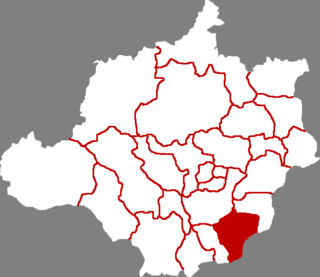
Li County or Lixian is a county under the jurisdiction of Baoding prefecture-level city, Hebei, China.
Lizhou District, formerly Shizhong District, is a district of Sichuan Province, China. It is under the administration of Guangyuan city.
Pukou Town is an urban town in Liling City, Zhuzhou City, Hunan Province, People's Republic of China.

The Lizhou Dam is a arch dam on the Muli River in Muli Tibetan Autonomous County, Sichuan Province, China. The primary purpose of the dam is hydroelectric power generation and when commissioned it will support a 355 MW power station. Water from the dam will be sent to a power station about 14.5 km (9.0 mi) to the southeast. The difference in elevation between the reservoir and power station will afford a hydraulic head of 177 m (581 ft). Preliminary construction on the project began in 2009 and the superstructures were approved in 2011. Pouring of roller-compacted concrete for the dam began in 2012. The dam began to impound its reservoir in December 2015.
The Muli is a river in Sichuan Province, China. It is the principal tributary of the Yalong River. Six dams are planned for the river, three of which, Kajiwa, Lizhou and Shangtongba are under construction. Dashawan Dam on the middle reaches of the river was completed in 2012.

Li Zhuhao is a Chinese competitive swimmer, specializing in butterfly. At the 2014 Asian Games, he won the silver medal in the 100 metre butterfly and the gold medal in the 4 × 100 m medley relay, setting the Asian Games record.
Shaanxi Circuit or Shaanxi Province was one of the major circuits during the Song dynasty. In 1072 it was split into Qinfeng Circuit and Yongxingjun Circuit.

Liangzhe Circuit (997–1160s) was one of the major circuits during the Song dynasty (960–1279). Its administrative area corresponds roughly to modern Zhejiang, Shanghai, and southern Jiangsu. The fertile Yangtze River Delta lay within Liangzhe Circuit, as did Lake Tai. Liangzhe was the wealthiest circuit in Song.
The Apostolic Prefecture of Lixian is Latin rite pre-diocesan jurisdiction of the Catholic Church with seat in Lixian, central China.



